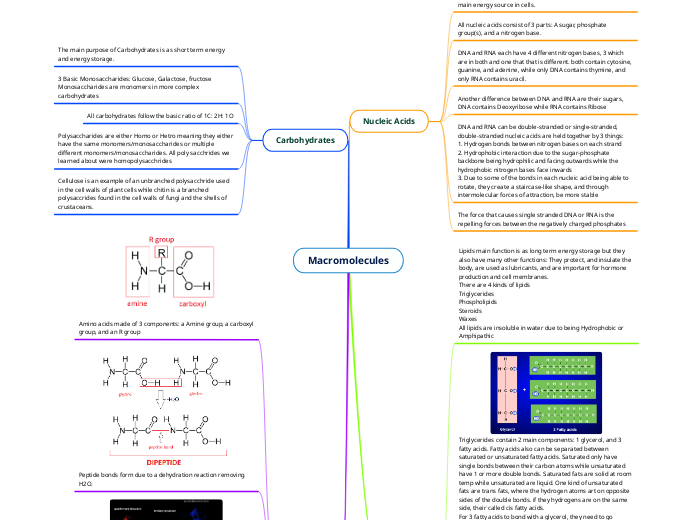Macromolecules
Nucleic Acids
Many different kinds of nucleic acids, for example, DNA and RNA contain instructions for vital cell functions while ATP is the main energy source in cells.
All nucleic acids consist of 3 parts: A sugar, phosphate group(s), and a nitrogen base.
DNA and RNA each have 4 different nitrogen bases, 3 which are in both and one that that is different. both contain cytosine, guanine, and adenine, while only DNA contains thymine, and only RNA contains uracil.
Another difference between DNA and RNA are their sugars, DNA contains Deoxyribose while RNA contains Ribose
DNA and RNA can be double-stranded or single-stranded, double-stranded nucleic acids are held together by 3 things:
1. Hydrogen bonds between nitrogen bases on each strand
2. Hydrophobic interaction due to the sugar-phosphate backbone being hydrophilic and facing outwards while the hydrophobic nitrogen bases face inwards
3. Due to some of the bonds in each nucleic acid being able to rotate, they create a staircase-like shape, and through intermolecular forces of attraction, be more stable
The force that causes single stranded DNA or RNA is the repelling forces between the negatively charged phosphates
Lipids
Lipids main function is as long term energy storage but they also have many other functions: They protect, and insulate the body, are used as lubricants, and are important for hormone production and cell membranes.
There are 4 kinds of lipids
Triglycerides
Phospholipids
Steroids
Waxes
All lipids are insoluble in water due to being Hydrophobic or Amphipathic
Triglycerides contain 2 main components: 1 glycerol, and 3 fatty acids. Fatty acids also can be separated between saturated or unsaturated fatty acids. Saturated only have single bonds between their carbon atoms while unsaturated have 1 or more double bonds. Saturated fats are solid at room temp while unsaturated are liquid. One kind of unsaturated fats are trans fats, where the hydrogen atoms art on opposite sides of the double bonds. if they hydrogens are on the same side, their called cis fatty acids.
For 3 fatty acids to bond with a glycerol, they need to go through dehydration synthesis, creating water as a biproduct
Phospholipids are just like triglycerides except that instead of having 3 fatty acids they have 2 and a phosphate groups. Phospholipids are unique due to the phospholipids heads being hydrophilic while the fatty acid tail are hydrophobic. this is extremely importing in the creation of cell membranes as the they arrange themselves with the head facing the outside and the tails facing the inside
Steroids are made of 4 carbon rings. Cholesterol is a steroid and is used in the synthesis of many other steroids such as testosterone, estrogen, and vitamin D. These hormones can have large affects on thee organisms
Waxes are the fourth and final kinds of lipids, they are used on the outer coating of leaves and in some animal ears. additionally they are also used in bee and wasp nests
Carbohydrates
The main purpose of Carbohydrates is as short term energy and energy storage.
3 Basic Monosaccharides: Glucose, Galactose, fructose
Monosaccharides are monomers in more complex carbohydrates
All carbohydrates follow the basic ratio of 1C: 2H: 1O
Polysaccharides are either Homo or Hetro meaning they either have the same monomers/monosaccharides or multiple different monomers/monosaccharides. All poly sacchrides we learned about were homopolysacchrides
Cellulose is an example of an unbranched polysacchride used in the cell walls of plant cells while chitin is a branched polysaccrides found in the cell walls of fungi and the shells of crustaceans.
Protiens
Amino acids made of 3 components: a Amine group, a carboxyl group, and an R group
Peptide bonds form due to a dehydration reaction removing H2O.
There are 4 levels of protein structures: primary structure, secondary, tertiary, and quaternary.
Primary: chain of amino acids
Secondary: either an alpha helix or beta-plated sheets
Tertiary: Intermolecular forces from hydrophobic and hydrophilic R groups and positively and negatively charged folding the protein into a 3D shape.
Quaternary: Multiple proteins and polypeptides working together to make one group. E.g. hemoglobin
There are lots of uses for proteins, some are: Enzymes, structural support, signaling, regulation, transport, senses, motor, defensive, and storage.
Signaling
2 main signaling systems in the body, the nervous and the endocrine system.
Hormones are chemical signals produced by glands in the endocrine system
Neurotransmitters are chemical signals produced by neurons in the nervous system
In both, proteins are the chemical signal, the molecule is usually a amino acid or a proteins. along with this, the receptor is also a protein
